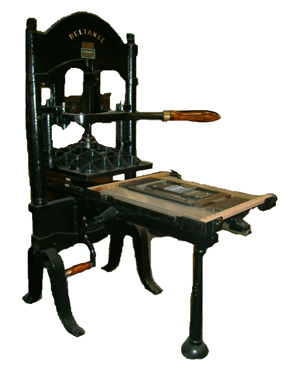
The
Reliance Press
c. 1895-1911

The Reliance press is a variation of the Washington
press invented in the early nineteenth century by
New York
printer Samuel Rust. Rust’s invention had
two important features that distinguished it from other iron hand presses
of the time. The initial patent of 1821 was for the “figure
4” toggle, which was less likely to come out
of its socket than previous toggles. The 1829 patent
for the press was for the
design of a new form of frame, which
incorporated hollow, cast-iron columns. The resulting press was significantly
lighter than other presses and could also be taken apart which allowed
easier shipping of the press, a key component of
its success. Many competing companies
produced and sold what were virtually direct copies of Rust’s patented
printing press, including his biggest competitor, R. Hoe & Co., of
New York, and eventually became the most popular iron hand presses.
Paul Schniedewend, of Chicago, manufactured
the Reliance presses between 1895 and 1911. New innovations
in printing
press technology had, by this point, rendered the iron
hand press obsolete for commercial printing. The Reliance
was designed with a new process in mind: photo-engraving.
The Reliance was specifically manufactured as a proofing
press that would produce high-quality impressions for
engravers. Schniedewend’s 1898 advertisement heralded “a
new press of unequalled strength and rigidity for proving
half-tone and process cuts”. Reliance presses
varied enormously in size, ranging from the Midget
(platen size
14.5 x 18.5 inches) and the Baby (platen size 10 x
8 inches) to the New A (975 lb.), New B (1,640 lb.),
Lion
(3000 lb.), the Mammoth (4,200 lb.) and by 1902, the
Mastodon (5,000 lb).
Saxe,
Stephen O., American Iron Hand Presses. Oak Knoll Books:
Newcastle, Delaware, 1992.
Moran, James. Printing Press: History and Development
from the Fifteenth Century to Modern Times. Faber and
Faber Limited: London, 1973.
This webpage was researched
and produced by
Jenny Gilbert.
|